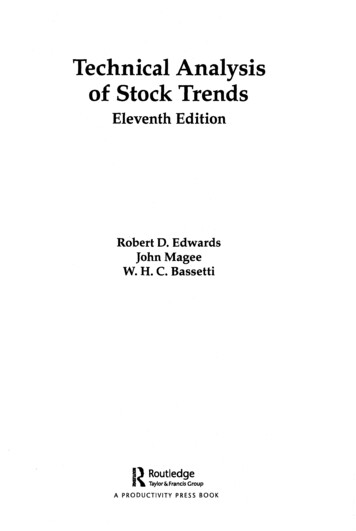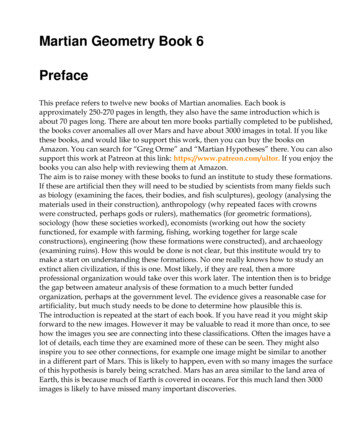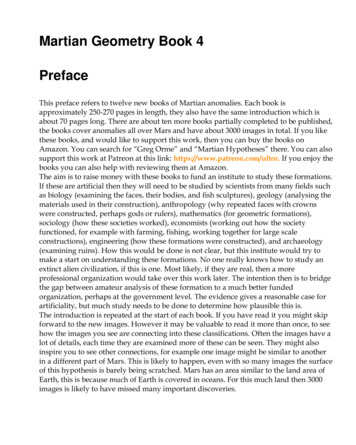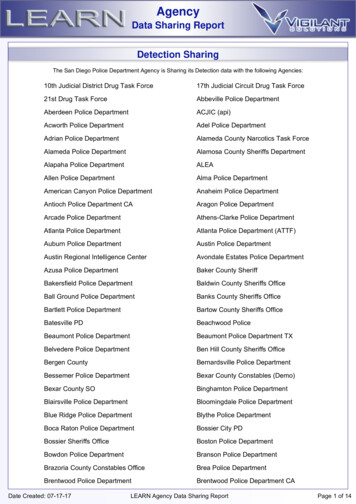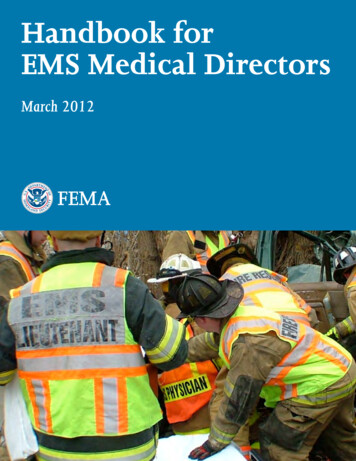
Transcription
PrefaceThe Overview Book has been published as part of the President’s Annual Defense Budget for thepast few years. From FY 1969 to FY 2005, OSD published the “Annual Defense Report” (ADR)to meet 10 USC section 113 requirements. Subsequently, the Overview began to fill this role.The Overview is one part of an extensive set of materials that constitute the presentation andjustification of the President’s Budget for FY 2022. This document and all other publications forthis and previous DoD budgets are available from the public web site of the Under Secretary ofDefense (Comptroller): http://comptroller.defense.gov.The Press Release and Budget Briefing, often referred to as the “Budget Rollout,” and the ProgramAcquisition Costs by Weapons System book, which includes summary details on major DoDacquisition programs (i.e., aircraft, ground forces programs, shipbuilding, space systems, etc.) areespecially relevant.The website for Performance Improvement tables and charts ormance-Plan-and-Performance-Report/.Other background information can be accessed at www.defense.gov.The estimated cost of this report or study forthe Department of Defense is approximately 31,000 for the 2021 Fiscal Year. This includes 13,000 in expenses and 18,000 in DoDlabor.Generated on 2021May19RefID: 4-93DCDF7i
This page intentionally left blankii
Overview – FY 2022 Defense BudgetTable of Contents1.FY 2022 Budget Summary1-1Introduction . 1-1Interim National Security Strategic Guidance – Renewing America’s Advantages . 1-3FY 2022 Budget Request Overview . 1-4Conclusion . 1-62.Defend the Nation2-1Defeat COVID-19 . 2-1China – The Pacing Challenge . 2-3Pacific Deterrence Initiative . 2-4Addressing Advanced and Persistent Threats . 2-6Power Projection . 2-63.Innovate and Modernize3-1Science and Technology . 3-1Advanced Capability Enablers. 3-2Space and Spaced-Based Systems . 3-3Cyberspace Activities . 3-4Tackling the Climate Crisis . 3-7Divestments . 3-84.Maintain and Enhance Military Readiness4-1Army Readiness . 4-2Navy Readiness . 4-4Marine Corps Readiness . 4-6Air Force Readiness . 4-9Space Force Readiness . 4-11United States Special Operations Command Readiness . 4-12Joint Capabilities . 4-145.Take Care of Our People5-1Grow Our Talent . 5-2Building Resilience and Force Readiness . 5-4Ensure Accountable Leadership. 5-10TABLE OF CONTENTSiii
Overview – FY 2022 Defense Budget6.Succeed Through Teamwork6-1Join Forces with Our Allies and Partners . 6-1Work in Partnership with Our Nation . 6-37.Contingency Operations7-1Movement of OCO to Base . 7-2Contingency Operations Categories. 7-2Current Operations . 7-2Contingency Operations Functional/Mission Category. 7-58.The Department of Defense Audit8-1The Department of Defense Audit Consolidated Audit Strategy . 8-2Audit Remediation . 8-3Budget . 8-4Data Analytics. 8-59.Reforms9-110. Military Departments10-1Army . 10-1Navy/Marine Corps . 10-13Air Force/Space Force . 10-2711. Performance Plan and Annual Performance ReportAppendix A. Resource Exhibits11-1A-1Table A-1 DoD Total Budget by Appropriation Title . A-1Table A-2 DoD Total Budget by Military Department . A-1Table A-3 DoD Total Budget by Military Department and Appropriation Title . A-1Table A-4 Combat Force Structure Overview . A-3Table A-5 Active Component End Strength (in Thousands). A-4Table A-6 Reserve Component End Strength (in Thousands) . A-4Appendix B. Acronym ListB-1 TABLE OF CONTENTSiv
Overview – FY 2022 Defense Budget1. FY 2022 BUDGET SUMMARY“DoD needs resources matched to strategy, strategy matched to policy, andpolicy matched to the will of the American people”- Secretary of Defense Lloyd J. Austin – Message to the ForceINTRODUCTIONThe Department of Defense’s (DoD) mission is to deteradversaries and defend the United States homeland and itscitizens. As global threats evolve, so too must theDepartment if we are to remain ready and capable ofthwarting the aims of adversaries. Accordingly, DoD’sFY 2022 budget request invests in the people, priorities,and purpose of mission that will renew America’sadvantages and support the United States’ efforts toadvance our defense priorities.Sections Introduction Interim National SecurityStrategic Guidance FY 2022 Budget RequestOverview ConclusionThe COVID-19 pandemic is the most urgent challenge facing our nation today, and its impact hashad far-reaching implications for the Department and its workforce, operations, and acquisitions.The DoD will support the Administration’s efforts to stop the pandemic and assist COVID-19 reliefefforts and vaccine distribution. Moreover, the FY 2022 budget invests in DoD’s capacity toprevent and respond to future pandemics and biological events. The pandemic has laid bare thevulnerability of both the nation and the force to biological events, the consequences of which mayonly grow in the future due to a changing climate, global preparedness and supply chainvulnerabilities, and advances in technology that facilitate creating and modifying dangerousagents.China poses the greatest long-term challenge to the United States, and strengthening deterrenceagainst China will require DoD to work in concert with other instruments of national power. Acombat-credible Joint Force will underpin a whole-of-nation approach to competition and ensurethe Nation leads from a position of strength. Accordingly, DoD will prioritize China and its militarymodernization as our pacing challenge. The Department will continue to modernize its forces,global posture, and operational concepts to ensure our armed forces are capable of deterring anddefending against aggression that undermines the security of both the United States and ourallies.As part of that effort, DoD is leveraging our technological advantages and investing in cuttingedge technologies that will deliver new warfighting advantages to our forces, including artificialintelligence, hypersonic technology, cyber, and quantum computing, among others. DoD isincreasing the speed and scale of innovation in the force, including the development,experimentation, and adoption of emerging capabilities and joint operational concepts to countercompetitors in both high-end and gray zone conflicts.The Department must also balance competing challenges that stem from advanced and persistentthreats to global security. DoD will remain fully ready to deter and, if necessary, respond tonation-state threats stemming from Russia, Iran, and North Korea, and will continue to disruptviolent extremist organizations that pose transnational and regional threats to U.S. forces and toour allies and partners.The United States also faces a growing climate crisis, and DoD recognizes that the country’s longterm security requires that we elevate climate as a national security priority. Where possible, DoDwill seek to lead the way for alternative climate-considered approaches for the country. DoD willintegrate climate considerations in all policies, strategies, and partner engagement activities.CHAPTER 1FY 2022 BUDGET SUMMARY1-1
Overview – FY 2022 Defense BudgetThere is no doubt that the climate crisis will have an impact on DoD’s missions, plans, andcapabilities, and the FY 2022 budget ensures the Department is prepared to meet thosechallenges head on.DoD recognizes that it cannot tackle these challenges alone and still achieve the Nation’s securityobjectives. Success will require teamwork—both with our international allies and partners, andwith the interagency, Congress, private industry, and the American people here at home. DoDwill prioritize rebuilding mutually beneficial defense partnerships, a strategic advantage that noU.S. competitor can match, and will work to align defense priorities to advance shared interests.At home, the Department will invest in American manufacturing, military families, and nationaldisaster and pandemic response infrastructure, ensuring the Department’s positive impacts arefelt across America as we work together to build back better.Finally, DoD’s greatest advantage is its workforce, supported by its military families. Taking careof our people and their physical, mental, and emotional health is among the Department’s highestpriorities because we cannot be ready without an energetic and empowered workforce. DoD willinvest in the growth and development of our workforce, including training, education, andopportunities for advancement that will improve promotion and retention for our total workforce,both civilian and military. DoD is committed to addressing the challenges that undermine ourability to attract and retain the highest quality Total Force, from housing and family support tosuicide and sexual assault prevention. The Department will ensure our force reflects the breadthof skills and talent of all those willing and able to serve across our diverse nation. By investing inAmerica’s enduring advantages, including our people, the FY 2022 budget ensures theDepartment can meet today’s challenges from a position of strength and ultimately build backbetter.Secretary Austin’s Message to the Force, released March 4, 2021, provides the overarchingstrategic framework for both the Department’s near-term priorities and for the DoD FY 2022budget request described herein.CHAPTER 1FY 2022 BUDGET SUMMARY1-2
Overview – FY 2022 Defense BudgetINTERIM NATIONAL SECURITY STRATEGIC GUIDANCE – RENEWINGAMERICA’S ADVANTAGES“It is our most solemn obligation to protect the security of the Americanpeople.”- President Joseph R. Biden, Jr. – Interim National Security Strategic GuidanceThe President’s Interim National Security Strategic Guidance (Interim Guidance), released onMarch 3, 2021, provides strategic direction to DoD and informs the Department’s priorities asreflected in the FY 2022 budget request. The Interim Guidance recognizes that preservingAmerica’s security requires a whole-of-government approach that leverages a broad range ofinstruments of national power. The military has a critical role to play in deterring war andprotecting the security of the United States, but it is only one instrument of foreign policy.Diplomacy, development, and economic statecraft—backed by highly capable armed forces thatare equipped to deter our adversaries and defeat threats that emerge—are the tools of first resortto advance America’s interests globally.The Interim Guidance’s elevation of diplomacy does not signify a weaker U.S. military; on thecontrary, it maintains that a powerful military matched to the security environment remains a coreAmerican advantage, and the United States will never hesitate to use force when required todefend our vital national interests. Accordingly, the readiness of our armed forces remains a toppriority to ensure that the U.S. military remains the best trained and equipped force in the world.To meet the strategic challenges posed by an increasingly assertive China, the Interim Guidancedirects DOD to shift resources away from vulnerable platforms and weapons systems that areill-suited to advanced threats and to redirect investments to cutting-edge technologies andcapabilities that will determine our military and national security advantage in the future. This willrequire streamlining the process for developing, acquiring, and deploying these technologies.Where possible the Interim Guidance emphasizes avoiding costly arms races and re-establishesU.S. credibility as a leader in arms control, including in the pursuit of new arms controlarrangements.The Interim Guidance recognizes that many of the greatest threats to American prosperity andsecurity—including the climate crisis, global pandemics, cyber threats, and nuclear proliferation—are borderless challenges that require collective action. In order to address those challenges, theUnited States must display global leadership and leverage the support of our allies and partnersworldwide. In particular, the United States will reinvigorate and modernize alliances andpartnerships around the world, including both our core alliances in the North Atlantic TreatyOrganization (NATO) and East Asia, and our partners in South and Southeast Asia and the PacificIslands. America’s network of allies and partners is a unique and powerful competitive advantage,and one that will help the United States tackle shared challenges, including climate change andChina-related defense priorities.Finally, the Interim Guidance prioritizes the health of the national security workforce and to inspirea new generation to public service. The Interim Guidance directs DoD to ensure it is a workplaceof equal opportunity that represents the diversity of the Nation, to eradicate workplace sexualharassment and assault, and to emphasize professional integrity, accountability, andtransparency at all times.The Interim Guidance drives our decision-making – focusing our resolve and effortson modernizing our military capabilities, while leading first with diplomacy; andrevitalize America’s unmatched network of alliances and partnerships.CHAPTER 1FY 2022 BUDGET SUMMARY1-3
Overview – FY 2022 Defense BudgetFY 2022 BUDGET REQUEST OVERVIEW“I am committed to ensuring that the Department develops the right people,priorities, and purpose of mission to continue to defend our Nation fromenemies foreign and domestic. This will require aligning our priorities andcapabilities to a changing and dynamic threat landscape. We will do so in away that is based on a sober assessment of our strategic needs and recognizethe importance of building and sustaining a strong workforce and unity withinour Department, across the Nation and with our allies and partners around theworld.”- Secretary of Defense Lloyd J. Austin – Message to the ForceThe DoD FY 2022 budget builds upon the foundation of the President’s Interim Guidance, whichfocuses on making smart and disciplined choices regarding our national defense and theresponsible use of our military, to ensure our armed forces are equipped to deter our adversaries,defend our people, interests, and allies, and defeat threats. Further guiding the Department’sefforts and this budget request are the Secretary’s following three priorities detailed in hisMessage to the Force:1. Defend the Nation Defeat COVID-19 – The Department will continue to act boldly and quickly to supportFederal Government efforts to defeat the disease, defend the force against it, and workwith our domestic and international partners to protect our Nation from potential noveland deadly viruses of the future. Prioritize China as the Pacing Threat – The Department will prioritize China as ournumber one pacing challenge and develop the right operational concepts, capabilities,and plans to bolster deterrence and maintain our competitive advantage. Address Advanced and Persistent Threats – We will ensure that we remain fullyready to respond to and effectively deter nation-state threats emanating from Russia,Iran, and North Korea, and disrupt transnational and non-state actor threats fromviolent extremist organizations, such as those operating in the Middle East, Africa, andSouth and Central Asia. Innovate and Modernize – The Department will innovate at a speed and scale thatmatches a dynamic threat landscape. This will require advances in our jointwarfighting concepts and a commitment to rapid experimentation and fielding ofcapabilities. Where necessary, we will divest of legacy systems and programs that nolonger meet our security needs, while investing smartly for the future. Tackle the Climate Crisis – We will elevate climate as a national security priority,integrating climate considerations into the Department's policies, strategies, andpartner engagements.2. Take Care of Our People Grow our Talent – We will build opportunities for growth and development in theDepartment, invest in training and education, and create new opportunities foradvancement that drive promotion and retention for our total workforce - civilian andmilitary.CHAPTER 1FY 2022 BUDGET SUMMARY1-4
Overview – FY 2022 Defense Budget Build Resilience and Readiness – The Department will maintain and enhance forcereadiness and protect the safety, health, and welfare of service members and theirfamilies, as well as our civilian employees. The Department will lead with our values,building diversity, equity, and inclusion into all aspects of our work to drive innovativesolutions across the enterprise. Ensure Accountable Leadership – DoD leaders at every level will be responsible forbuilding a safe environment for our people and guaranteeing that we show swift andclear accountability to anyone who does not act within the highest standards of theDepartment.3. Succeed through Teamwork Join Forces with our Allies and Partners – We will consult with our allies andpartners and, when appropriate, we will act together. Work in Partnership with Our Nation – We will redouble our commitment to acooperative, whole-of-nation approach to national security that builds consensus,drives creative solutions to crises, and guarantees that we lead from a position ofstrength -fielding a credible force, ready to back up the hard work of our diplomatsaround the world and our national partners here at home. Build Unity within DoD – We will continue to build unity of effort and mission acrosscomponents, commands, services, and theaters, and we will demonstrate teamworkat the highest levels of the Department and expect it across every level, knowing thatworking collaboratively together will ensure the greatest success in protecting anddefending our Nation.Figure 1.1. Department of Defense BudgetFY 2020 in billionsActuals1Base704.6Emergency Supplementals2TotalFY 2021Enacted703.7FY 2022Request715.0FY21-FY22Change 11.318.6------723.2703.7715.0 11.31Includes Overseas Contingency Operations/Direct War and Enduring Operations Cost in all years2FY 2020 includes supplemental funding for COVID-19 and Natural Disaster ReliefThe President’s FY 2022 budget request for DoD is 715 billion. This budget represents an 11.3 billion or 1.6 percent increase over the FY 2021 enacted level. While this increase isslightly less than the anticipated rate of inflation for FY 2022, this funding level, coupled with thetough choices the Department made to realign resources and divest legacy systems, enablesDoD to – Sustain and advance readiness; Protect investments in critical deterrent capabilities such as long range strike, nextgeneration air, advanced munitions, and maritime response; Reallocate resources to fund climate resiliency, clean energy, and research anddevelopment in advanced technologies; andCHAPTER 1FY 2022 BUDGET SUMMARY1-5
Overview – FY 2022 Defense Budget Fund both military and civilian pay raises to ensure that the Department can attract andretain top talent.“Defending America also means setting clear priorities within our defensebudget.”- President Joseph R. Biden, Jr. – Interim National Security Strategic GuidanceFigure 1.2. DoD Topline Funding FY 2018 – 2022Discretionary Budget AuthorityThen Year Dollars in BillionsNumbers may not add due to rounding* FY 2022 Includes 42.1 billion for Direct War and Enduring Operations costs in the base requestCONCLUSIONSustainable, predictable, adequate, and timely budgets are paramount to achieving the Nation’ssecurity objectives in an efficient and effective manner. The FY 2022 budget aligns theDepartment’s priorities and capabilities to a changing and dynamic threat landscape bycapitalizing on the unmatched strength of America’s innovative workforce, unwaveringcommitment to democratic values, and unrivaled global alliances and partnerships.Congressional approval of the FY 2022 budget will solidify and renew America’s advantages overthe coming decades, while holding DoD spending near historical lows as a share of the U.S.economy.CHAPTER 1FY 2022 BUDGET SUMMARY1-6
Overview – FY 2022 Defense Budget2. DEFEND THE NATION“Challengers who seek to undermine America's interests by force should neverdoubt America's resolve or readiness to thwart their aims.”- Deputy Secretary of Defense Dr. Kathleen H. HicksThe Fiscal Year (FY) 2022 budget request for theDepartment of Defense (DoD) seeks to strengthen theability of U.S. forces to defend the United Stateshomeland, its citizens, and its allies and partners fromaggression. The DoD will prioritize activities that will deterand defend against aggression in the Indo-Pacific region,while also maintaining the capacity and capabilities torespond to current and evolving threats around the globe.While China represents the pacing challenge that informsnew investments in power projection capabilities,cutting-edge defense technologies, and enhancedregional posture, the United States does not have theluxury of ignoring persistent advanced threats outside theIndo-Pacific.Sections Defeat COVID-19 China – The Pacing Challenge Pacific Deterrence Initiative Addressing Advanced andPersistent Threats – Russia,Iran, North Korea, and ViolentExtremist Organizations Power ProjectionProtecting the United States, forward-deployed U.S. forces, and allies is critical to deterring attackfrom adversaries and maintaining credible U.S. security commitments across the globe.Accordingly, the FY 2022 President’s Budget request prioritizes investments that will preserve themilitary’s ability to project power globally against a full spectrum of threats. To make room fornew capabilities, DoD is rightsizing programs and operations optimized for an earlier era and thatno longer meet the Nation’s security needs.DEFEAT COVID-19“The greatest proximate challenge to our Nation's security is the threat ofCOVID-19.”- Secretary of Defense Lloyd J. Austin – Message to the ForceThe Department has brought to bear its substantial capabilities and resources, consistent withthe law and mindful of DoD’s own mission requirements, to support the Nation’s fight against theCOVID-19 pandemic. Since January 27, 2021, the Department has received 495 FEMA mission assignmentsand 66 requests for assistance from other Federal departments and agencies in responseto the COVID-19 pandemic.oMore than 62,100 personnel, including National Guard from all 50 States, 3 territories,and the District of Columbia have supported the fight against COVID-19.oNearly 5,000 of the Department’s medical professionals deployed to ten States,sometimes to multiple locations within one State. Two Navy hospital ships, severalNavy Expeditionary Medical Facilities, Army Combat Hospital Centers, Army ReserveUrban Augmentation Medical Task Forces, and Air Force Expeditionary MedicalSupport units provided surge medical support on ships, at alternate care facilities, andin civilian hospitals and nursing homes.CHAPTER 2DEFEND THE NATION2-1
Overview – FY 2022 Defense Budget oSince January 27, 2021 more than 4,600 DoD personnel have supported the nationalvaccination effort in California, Colorado, Florida, Georgia, Illinois, Indiana, Kentucky,Louisiana, Maryland, Massachusetts, Michigan, Minnesota, Missouri, New Jersey,New York, North Carolina, Ohio, Oklahoma, Oregon, Pennsylvania, Tennessee,Texas, Virginia, Washington, Wisconsin, Guam, and the U.S. Virgin Islands. As ofMay 10, 2021, the Department is supporting 31 Community Vaccination Centers withmore than 3,800 personnel.oTo date, the total FEMA obligation amount for DoD medical support is 4.9 billion,provided on a reimbursable basis pursuant to the Stafford Act. However, FEMA is notreimbursing the Department for TRICARE costs incurred by the loss of medicalpersonnel to assist with FEMA mission assignments.oThe Defense Logistics Agency (DLA) has delivered more than 230 million rapid “pointof-care” antigen tests to support HHS nationwide COVID-19 relief efforts in more than14,500 locations, including States, nursing homes, and schools.oDLA has executed 30,711 contract actions, obligating more than 3.6 billion to providecritical lifesaving medical supplies, including test kits, ventilators, pharmaceuticaldrugs, and Personal Protective Equipment (PPE), such as masks, gloves, and gowns,to meet customer demands and support the Strategic National Stockpile. Along withPPE, DLA also provided food, clothing, fuel, construction materials, and repair partsto DoD and other Federal agencies.oThe Department supported the Department of State’s repatriation of more than4,500 U.S. citizens stranded abroad due to the pandemic.oIn support of Project Air Bridge, U.S. Transportation Command (USTRANSCOM)delivered into the private sector supply chain: nearly 1.5 million N95 respirators;937 million gloves; 112.7 million surgical masks; 39.4 million surgical gowns; morethan 2.4 million thermometers; more than 2.5 million face shields; 1.4 million coveralls;109,000 stethoscopes; 370,000 oxygen masks; and more than 160,000 cannulas.The Department aimed decades’ worth of experience studying infectious diseases ofmilitary importance, including HIV/AIDS, Ebola, and coronaviruses such as Middle EastRespiratory Syndrome (MERS), at the Department’s DoD laboratories on the COVID-19pandemic.oIn January 2020, the Department began research and development (R&D) ondiagnostics, therapeutics, and vaccines for SARS-CoV-2, the strain of coronavirus thatcauses COVID-19.oThe Defense Health Program Medical R&D funds provided the initial infusion requiredto support early COVID-19 research efforts.oThe Department is investing over 1.3 billion from the CARES Act towards R&D fornew medical countermeasures. Investments are balanced with near, mid, andlong-term solutions with tailored strategies focused on rapid delivery, leveragingaccelerated regulatory mechanisms (e.g., Emergency Use Authorization (EUA)) tosupport new medical countermeasures to survey, prevent, diagnose, and treatCOVID-19.CHAPTER 2DEFEND THE NATION2-2
Overview – FY 2022 Defense Budget VaccinationoAs of May 10, 2021, the Department’s personnel administered more than 7.7 millioncumulative doses to Defense personnel and the general public though DoD SupportedCommunity Vaccination Centers.oAs of May 10, 2021, 609
The Overview Book has been published as part of the President's Annual Defense Budget for the past few years. From FY 1969 to FY 2005, OSD published the "Annual Defense Report" (ADR) to meet 10 USC section 113 requirements. Subsequently, the Overview began to fill this role.
